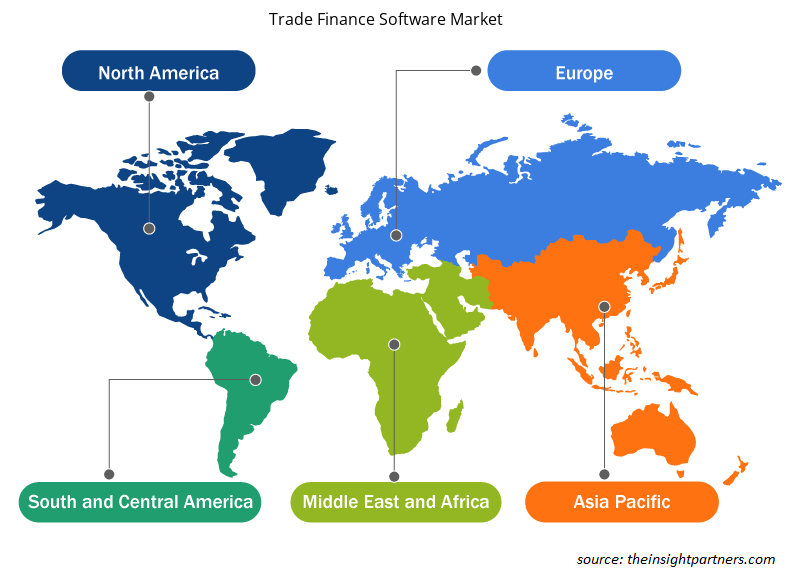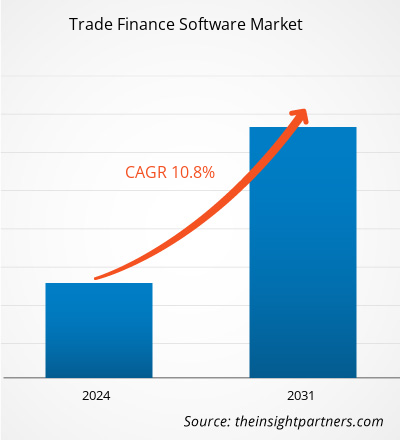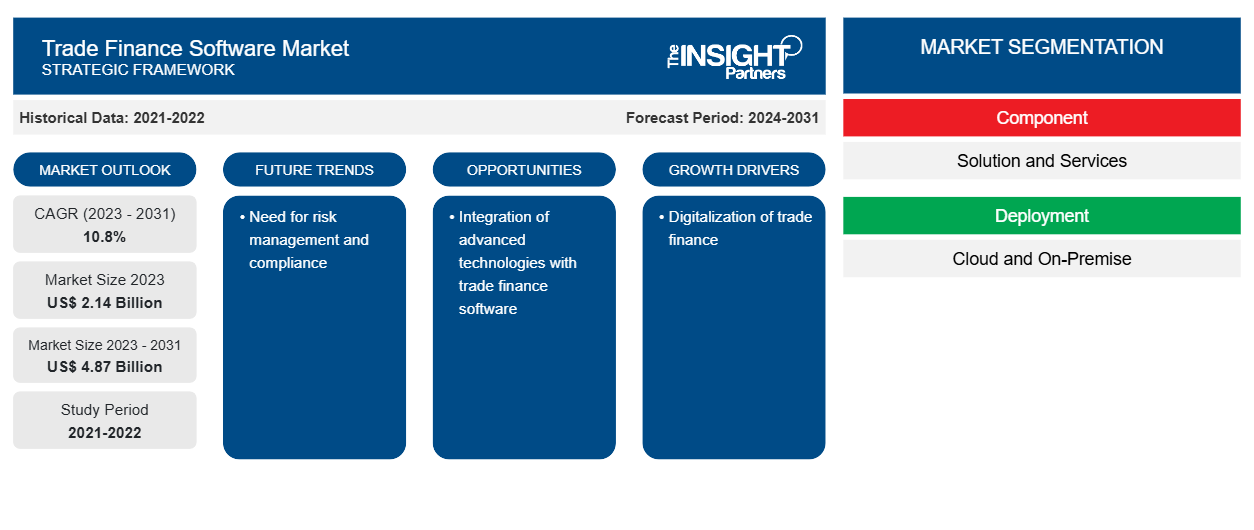من المتوقع أن يصل حجم سوق برمجيات التمويل التجاري إلى 4.87 مليار دولار أمريكي بحلول عام 2031 من 2.14 مليار دولار أمريكي في عام 2023. ومن المتوقع أن يسجل السوق معدل نمو سنوي مركب بنسبة 10.8٪ في الفترة 2023-2031. ومن المرجح أن يظل التحول الرقمي المتزايد وتبني التقنيات القائمة على السحابة من أهم اتجاهات سوق برمجيات التمويل التجاري.
تحليل سوق برامج التمويل التجاري
إن التحول الرقمي المتزايد لعمليات التمويل التجاري يشكل عاملاً رئيسيًا في تعزيز نمو سوق برامج التمويل التجاري. ومع زيادة الكفاءة وانخفاض التكاليف، تحل الوثائق الإلكترونية وحلول التمويل التجاري المستندة إلى السحابة محل الأساليب الورقية التقليدية بشكل متزايد، مما يساهم في نمو السوق.
نظرة عامة على سوق برامج التمويل التجاري
لقد أدت الحاجة إلى الشفافية والالتزام باللوائح التجارية الدولية إلى تبني حلول برمجية تتميز بميزات المراقبة والإبلاغ في الوقت الفعلي. ومع التركيز على توفير حلول متطورة تلبي الاحتياجات المتغيرة للتجارة الدولية، فإن سوق برمجيات التمويل التجاري على استعداد لمزيد من التوسع مع استمرار تغير المشهد التجاري العالمي وسعي الشركات إلى عمليات تمويل تجاري أكثر أمانًا وكفاءة.
قم بتخصيص هذا التقرير ليناسب متطلباتك
ستحصل على تخصيص لأي تقرير - مجانًا - بما في ذلك أجزاء من هذا التقرير، أو تحليل على مستوى الدولة، وحزمة بيانات Excel، بالإضافة إلى الاستفادة من العروض والخصومات الرائعة للشركات الناشئة والجامعات
-
احصل على أهم اتجاهات السوق الرئيسية لهذا التقرير.ستتضمن هذه العينة المجانية تحليلاً للبيانات، بدءًا من اتجاهات السوق وحتى التقديرات والتوقعات.
محركات وفرص سوق برامج التمويل التجاري
رقمنة التمويل التجاري لصالح السوق
مع إدراك الشركات من مجموعة متنوعة من الصناعات أنها بحاجة إلى حلول متطورة لتسريع وتحسين عمليات التجارة الدولية الخاصة بها، فإن السوق يتوسع بشكل كبير. يشمل هذا السوق برامج مصممة لتحسين وأتمتة إجراءات تمويل التجارة ، مثل تمويل سلسلة التوريد، وإدارة الامتثال، وخصم الفواتير، وإدارة الائتمان. لجأت المنظمات إلى برامج تمويل التجارة لتقليل المهام اليدوية والمستهلكة للوقت، وتحسين الدقة، وتقليل المخاطر المرتبطة بالتجارة الدولية نتيجة للتعقيد المتزايد وحجم المعاملات التجارية، مما يؤدي إلى اعتماد برامج تمويل التجارة من قبل اللاعبين في السوق. على سبيل المثال، في نوفمبر 2023، أعلنت شركة فيناسترا، وهي شركة عالمية تقدم تطبيقات وأسواق البرامج المالية، أن بنك CQUR، وهو بنك مؤسسي دولي، قد دخل في شراكة مع فيناسترا لتحقيق استراتيجيتها التكنولوجية. من خلال تنفيذ حلول فيناسترا الرائدة في السوق، Trade Innovation and Corporate Channels، يقدم بنك CQUR لعملائه من الشركات بوابة مصرفية عبر الإنترنت جديدة لتجربة مستخدم سلسة، وقدم تدفقات عمل رقمية جديدة، ويوفر حلول تكامل من مضيف إلى مضيف.
الحاجة إلى إدارة المخاطر والامتثال
إن الحاجة المتزايدة لتحسين إدارة المخاطر والامتثال هي عامل آخر يدفع نمو سوق برامج التمويل التجاري. تقدم برامج التمويل التجاري أدوات متطورة، مثل الكشف عن الاحتيال، والتحقق من مكافحة غسل الأموال ، والامتثال لقوانين التجارة والعقوبات، لتتبع وتقليل المخاطر المتعلقة بالتجارة الدولية. وتستمر الحاجة إلى حلول البرامج هذه في النمو مع محاولة الشركات والمؤسسات المالية إدارة تحديات التجارة الدولية مع الحفاظ على الامتثال القانوني والتنظيمي.
تقرير تحليل تجزئة سوق برامج التمويل التجاري
إن القطاعات الرئيسية التي ساهمت في استخلاص تحليل سوق برامج التمويل التجاري هي المكون، والنشر، وحجم المؤسسة، والاستخدام النهائي.
- بناءً على المكون، يتم تقسيم السوق إلى حلول وخدمات. احتل قطاع الحلول حصة سوقية أكبر في عام 2023.
- من حيث النشر، يتم تقسيم السوق إلى سحابية ومحلية. احتلت شريحة السحابة حصة سوقية أكبر في عام 2023.
- من حيث حجم المؤسسة، يتم تقسيم السوق إلى شركات كبيرة وشركات صغيرة ومتوسطة الحجم. ومن المتوقع أن ينمو قطاع الشركات الصغيرة والمتوسطة الحجم بأعلى معدل نمو سنوي مركب.
- من حيث الاستخدام النهائي، يتم تقسيم السوق إلى بنوك وتجار وغيرهم. احتلت شريحة البنوك حصة سوقية أكبر في عام 2023.
تحليل حصة سوق برامج التمويل التجاري حسب المنطقة الجغرافية
ينقسم النطاق الجغرافي لتقرير سوق برمجيات التمويل التجاري بشكل أساسي إلى خمس مناطق: أمريكا الشمالية، ومنطقة آسيا والمحيط الهادئ، وأوروبا، والشرق الأوسط وأفريقيا، وأمريكا الجنوبية/أمريكا الجنوبية والوسطى.
من حيث الإيرادات، استحوذت أمريكا الشمالية على أكبر حصة سوقية لبرامج التمويل التجاري في عام 2023. تعد أمريكا الشمالية من أوائل الدول التي تبنت الحلول التكنولوجية مما أدى إلى ارتفاع حصتها السوقية. يؤدي تبني الشركات الصغيرة والمتوسطة للتكنولوجيات القائمة على السحابة إلى نمو السوق. كما يتطلب التحول الرقمي المتزايد في البنوك المزيد من برامج التمويل التجاري، مما يؤدي إلى زيادة حصة سوق التمويل التجاري في أمريكا الشمالية.
رؤى إقليمية حول سوق برامج التمويل التجاري
لقد قام المحللون في Insight Partners بشرح الاتجاهات والعوامل الإقليمية المؤثرة على سوق برامج التمويل التجاري طوال فترة التوقعات بشكل شامل. يناقش هذا القسم أيضًا قطاعات سوق برامج التمويل التجاري والجغرافيا في جميع أنحاء أمريكا الشمالية وأوروبا ومنطقة آسيا والمحيط الهادئ والشرق الأوسط وأفريقيا وأمريكا الجنوبية والوسطى.

- احصل على البيانات الإقليمية المحددة لسوق برامج التمويل التجاري
نطاق تقرير سوق برامج التمويل التجاري
| سمة التقرير | تفاصيل |
|---|---|
| حجم السوق في عام 2023 | 2.14 مليار دولار أمريكي |
| حجم السوق بحلول عام 2031 | 4.87 مليار دولار أمريكي |
| معدل النمو السنوي المركب العالمي (2023 - 2031) | 10.8% |
| البيانات التاريخية | 2021-2022 |
| فترة التنبؤ | 2024-2031 |
| القطاعات المغطاة |
حسب المكون
|
| المناطق والدول المغطاة |
أمريكا الشمالية
|
| قادة السوق وملفات تعريف الشركات الرئيسية |
|
كثافة اللاعبين في سوق برمجيات التمويل التجاري: فهم تأثيرها على ديناميكيات الأعمال
يشهد سوق برامج التمويل التجاري نموًا سريعًا، مدفوعًا بالطلب المتزايد من جانب المستخدم النهائي بسبب عوامل مثل تفضيلات المستهلكين المتطورة والتقدم التكنولوجي والوعي المتزايد بفوائد المنتج. ومع ارتفاع الطلب، تعمل الشركات على توسيع عروضها والابتكار لتلبية احتياجات المستهلكين والاستفادة من الاتجاهات الناشئة، مما يؤدي إلى زيادة نمو السوق.
تشير كثافة اللاعبين في السوق إلى توزيع الشركات أو المؤسسات العاملة في سوق أو صناعة معينة. وهي تشير إلى عدد المنافسين (اللاعبين في السوق) الموجودين في مساحة سوق معينة نسبة إلى حجمها أو قيمتها السوقية الإجمالية.
الشركات الرئيسية العاملة في سوق برمجيات التمويل التجاري هي:
- شركة سي جي آي
- كومارتش إس إيه
- اي بي اس في ان تك
- شركة اي سي اس للأنظمة المالية المحدودة
- MITech - Make Intuitive Tech SA
- نيوجين لتقنيات البرمجيات المحدودة
إخلاء المسؤولية : الشركات المذكورة أعلاه ليست مرتبة بأي ترتيب معين.

- احصل على نظرة عامة على أهم اللاعبين الرئيسيين في سوق برمجيات التمويل التجاري
أخبار سوق برامج التمويل التجاري والتطورات الأخيرة
يتم تقييم سوق برامج التمويل التجاري من خلال جمع البيانات النوعية والكمية بعد البحث الأولي والثانوي، والتي تتضمن منشورات الشركات المهمة وبيانات الجمعيات وقواعد البيانات. فيما يلي قائمة بالتطورات في السوق:
- في سبتمبر 2022، أطلقت شركة Newgen Software، وهي شركة عالمية رائدة في مجال توفير منتجات التحول الرقمي، أول منصة تمويل تجاري منخفضة التكلفة في العالم في اجتماع العملاء في مومباي. يعد تمويل التجارة عملية معقدة لأنها تنطوي على الكثير من الأعمال الورقية، وأصحاب المصلحة المتعددين، ومتطلبات الامتثال. تساعد منصة تمويل التجارة الشاملة والقابلة للتكوين والجاهزة للمستقبل من Newgen البنوك على الاستغناء عن الورق وتبسيط عمليات التجارة الشاملة مع ضمان الامتثال للوائح المحلية والدولية. (المصدر: CXOtoday، بيان صحفي، 2022)
- في فبراير 2024، أعلنت شركة فيناسترا، وهي شركة عالمية تقدم تطبيقات وأسواق برمجيات مالية، وشركة تيسيليت، وهي شركة استشارية ومتكاملة للتحول الرقمي العالمي، عن إطلاق خدمة جاهزة من البداية إلى النهاية لتسريع وتسهيل رقمنة التمويل التجاري. تتيح خدمة تيجولا للتمويل التجاري كخدمة، التي تعمل بتقنية الابتكار التجاري والقنوات المؤسسية من فيناسترا، للبنوك الأمريكية أتمتة العمليات اليدوية والتكيف مع المتطلبات الجديدة مع وقت أسرع للتسويق والقيمة. من خلال منصة FusionFabric.cloud من فيناسترا، يمكن للبنوك أيضًا دمج تطبيقات التكنولوجيا المالية التي تستخدم أحدث التقنيات مثل الذكاء الاصطناعي والبلوك تشين وأدوات الأتمتة بسلاسة. (المصدر: فيناسترا، بيان صحفي، 2024)
تقرير سوق برامج التمويل التجاري والتغطية والنتائج المتوقعة
يوفر تقرير "حجم سوق برمجيات التمويل التجاري والتوقعات (2021-2031)" تحليلاً مفصلاً للسوق يغطي المجالات التالية:
- حجم السوق والتوقعات على المستويات العالمية والإقليمية والوطنية لجميع قطاعات السوق الرئيسية التي يغطيها النطاق
- ديناميكيات السوق مثل المحركات والقيود والفرص الرئيسية
- الاتجاهات المستقبلية الرئيسية
- تحليل مفصل لقوى PEST/Porter الخمس وSWOT
- تحليل السوق العالمي والإقليمي الذي يغطي اتجاهات السوق الرئيسية واللاعبين الرئيسيين واللوائح والتطورات الأخيرة في السوق
- تحليل المشهد الصناعي والمنافسة الذي يغطي تركيز السوق، وتحليل خريطة الحرارة، واللاعبين البارزين، والتطورات الأخيرة
- ملفات تعريف الشركة التفصيلية
- التحليل التاريخي (سنتان)، سنة الأساس، التوقعات (7 سنوات) مع معدل النمو السنوي المركب
- تحليل PEST و SWOT
- حجم السوق والقيمة / الحجم - عالمي، إقليمي، بلد
- الصناعة والمنافسة
- مجموعة بيانات إكسل
التقارير الحديثة
تقارير ذات صلة
شهادات العملاء
سبب الشراء
- اتخاذ قرارات مدروسة
- فهم ديناميكيات السوق
- تحليل المنافسة
- رؤى العملاء
- توقعات السوق
- تخفيف المخاطر
- التخطيط الاستراتيجي
- مبررات الاستثمار
- تحديد الأسواق الناشئة
- تحسين استراتيجيات التسويق
- تعزيز الكفاءة التشغيلية
- مواكبة التوجهات التنظيمية























 احصل على عينة مجانية ل - سوق برمجيات التمويل التجاري
احصل على عينة مجانية ل - سوق برمجيات التمويل التجاري